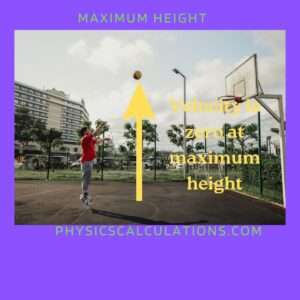Answer:
The answer to this question (is velocity 0 at max height) is yes. The velocity of an object at maximum height is zero.
Explanation to “is velocity 0 at max height”
When you throw an object into the sky, for example, a basketball. There are multiple forces acting on the ball. Here is the list of forces that will be acting on the ball:

1. Newton’s second law
According to newton’s second law of motion, “the rate of change of momentum is directly proportional to the applied force and takes place in the direction of the force.”. It shows that you will need to apply force to throw the ball in an upward direction.
Thus, as the ball continues to move up, it will reach a point where the applied force will be exhausted and the ball will start coming back to the ground.
Hence, the height covered before it starts coming back to the ground is the maximum height. And at that height, the body possesses zero acceleration which will lead to deceleration.
Force = mass x acceleration
Therefore, as the acceleration keeps reducing, so is the velocity. And once the acceleration reaches its peak displacement, it will become zero. Hence, the velocity will also become zero.
Here is another explanation, momentum is the product of velocity and mass. And as the ball moves up, its velocity will keep reducing until it reaches zero.
Hence, the height at which the velocity reached zero is the ball’s maximum height. Therefore, at the maximum height, the velocity is zero.
2. Effect of Weight
Similarly, when you throw a ball upward, a force of gravity pulls it down due to its weight. This is because the earth is surrounded by a gravitational field.
Thus, acceleration due to gravity will continue to act on the ball until it cancels the external you applied on the ball. Hence, it will reach a threshold where it will hang and then start coming back to the surface of the earth.
The position where it hangs is the maximum height, and the velocity at that height is zero. Remember that weight is the product of mass and the force due to gravity. Thus, w = mg
3. Due to Decelaration
Additionally, here is the more accurate answer and simple explanation to “is velocity 0 at max height”. When you throw a ball up, it will gain momentum, and its acceleration will keep decreasing.
As the acceleration keeps reducing, the velocity of the ball will also be affected. The velocity will also continue to reduce along with the ball’s acceleration until it reaches zero (0).
Once the velocity of the ball reaches zero, this shows that the ball has reached its maximum height. It will then return down through the process of deceleration.
Additionally, when the ball reaches its maximum height it will be forced to come back to the ground due to acceleration due to gravity. When an object returns to the ground after reaching maximum height, it will undergo retardation which is negative acceleration.
And for an object to move from positive to negative acceleration, it must cross a zero mark. Therefore, the velocity at maximum height is zero because when an object is falling, its velocity will become negative
4. Kinetic Energy Vs Potential Energy
When you throw an object up, it will gain kinetic energy, its kinetic energy will keep decreasing until it reaches zero and then gets converted into potential energy.
The height at which the kinetic energy reaches zero is called maximum height. Don’t forget that kinetic energy consists of mass and velocity.
Therefore, when the kinetic energy is zero, the velocity is also zero. Hence, the velocity at maximum height is zero.
Displacement Scenario
Velocity is the rate of change of displacement with time. Let’s assume you throw a ball to cover a distance of 20 meters before it returns to the floor in 10 seconds. It means the maximum height is a distance covered in 20 meters.
Also, remember that displacement is the distance covered in a specific direction (vector quantity). Thus, our displacement is 20 meters. However, the ball returned to its initial position. Hence, the displacement covered while returning to its initial position is 20 meters. We can now show that:
This means that the total displacement is 20 m – 20 m = 0
But Velocity, v = total displacement / time = 0 / 10 = 0
Hence, velocity is zero (0)
Therefore, the answer to the question “is velocity 0 at max height” is yes.
Sources